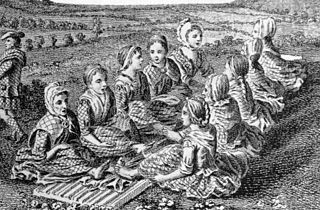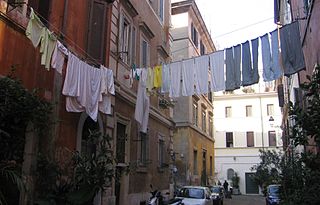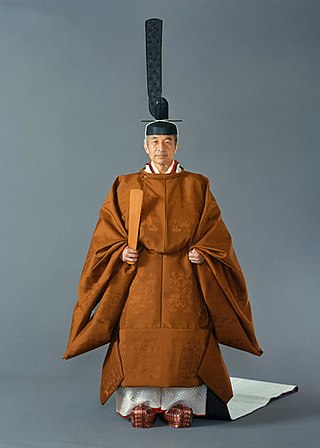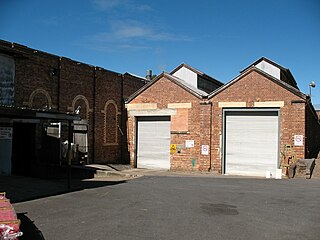
Fulling, also known as tucking or walking, is a step in woollen clothmaking which involves the cleansing of woven cloth to eliminate (lanolin) oils, dirt, and other impurities, and to make it shrink by friction and pressure. The work delivers a smooth, tightly finished fabric that is insulating and water-repellent. Well-known examples are duffel cloth, first produced in Flanders in the 14th century, and loden, produced in Austria from the 16th century on.

Laundry is the washing of clothing and other textiles, and, more broadly, their drying and ironing as well. Laundry has been part of history since humans began to wear clothes, so the methods by which different cultures have dealt with this universal human need are of interest to several branches of scholarship.

A longyi is a sheet of cloth widely worn in Myanmar (Burma). It is approximately 2 metres (6.6 ft) long and 80 centimetres (2.6 ft) wide. The cloth is often sewn into a cylindrical shape. It is worn around the waist, running to the feet, and held in place by folding fabric over without a knot. In ancient times, Lethwei fighters would hitch it up to compete. This folding technique is still being used in modern days when people play chinlone.
Hodden is a coarse, undyed cloth made of undyed wool, formerly much worn by the peasantry of Scotland from prehistory. Hodden, with wadmal, represent two similar cultural fabrics in Scottish history. Hodden is an early-modern period name for a primarily Gaelic fabric, earlier named lachdann in Gaelic, and even earlier lachtna in Old Irish; while wadmal was a Scandinavian fabric, in the now-Scottish islands and Highlands. Both are usually woven in 2/2 twill weave but are also known in plain or tabby weave. Both are a thick, coarse, fulled homespun cloth typically made of natural undyed wool of the vari-coloured Northern European short-tailed sheep breeds. The Scots preferred to breed strains of sheep in various areas to provide the local preferred colour of natural wool used for cloth to protect the poor and rural peasants from the elements.
Long Èireannach is a well known song in the Scottish Gaelic tradition known as Orain Luaidh, or waulking song, a type of work song that is sung by the women when fulling cloth. In Long Èireannach the sweetheart of each girl present is named in turn by the singers as the song proceeds, the whole of the workers taking up the chorus.

Dalgarven Mill is near Kilwinning, in the Garnock Valley, North Ayrshire, Scotland and it is home to the Museum of Ayrshire Country Life and Costume. The watermill has been completely restored over a number of years and is run by the independent Dalgarven Mill Trust.
Flounder tramping is a traditional method of catching flounder or other flat fish by wading in shallow water and standing on them.

Broadcloth is a dense, plain woven cloth, historically made of wool. The defining characteristic of broadcloth is not its finished width but the fact that it was woven much wider and then heavily milled in order to shrink it to the required width. The effect of the milling process is to draw the yarns much closer together than could be achieved in the loom and allow the individual fibres of the wool to bind together in a felting process, which results in a dense, blind face cloth with a stiff drape which is highly weather-resistant, hard wearing and capable of taking a cut edge without the need for being hemmed.

Waulking songs are Scottish folk songs, traditionally sung in the Gaelic language by women while fulling (waulking) cloth. This practice involved a group of women, who traditionally prepared cloth, rhythmically beating newly woven tweed or tartan cloth against a table or similar surface to lightly felt it and shrink it to better repel water. Simple, beat-driven songs were used to accompany the work.
The manufacture of textiles is one of the oldest of human technologies. To make textiles, the first requirement is a source of fiber from which a yarn can be made, primarily by spinning. The yarn is processed by knitting or weaving, which turns it into cloth. The machine used for weaving is the loom. For decoration, the process of colouring yarn or the finished material is dyeing. For more information of the various steps, see textile manufacturing.

A fullo was a Roman fuller or laundry worker, known from many inscriptions from Italy and the western half of the Roman Empire and references in Latin literature, e.g. by Plautus, Martialis and Pliny the Elder. A fullo worked in a fullery or fullonica. There is also evidence that fullones dealt with cloth straight from the loom, though this has been doubted by some modern scholars. In some large farms, fulleries were built where slaves were used to clean the cloth. In several Roman cities, the workshops of fullones, have been found. The most important examples are in Ostia and Pompeii, but fullonicae also have been found in Delos, Florence, Fréjus and near Forlì: in the Archaeological Museum of Forlì, there is an ancient relief with a fullery view. While the small workshops at Delos go back to the 1st century BC, those in Pompeii date from the 1st century AD and the establishments in Ostia and Florence were built during the reign of the Emperors Trajan and Hadrian.

The sokutai (束帯) is a traditional Japanese outfit worn only by courtiers, aristocrats and the emperor at the Japanese imperial court. The sokutai originated in the Heian period, and consists of a number of parts, including the ho, shaku (笏), a flat ritual baton or sceptre, and the kanmuri (冠), a cap-shaped black lacquered silk hat with a pennon.

The Welsh traditional costume was worn by rural women in Wales. It was identified as being different from that worn by the rural women of England by many of the English visitors who toured Wales during the late 18th and early 19th centuries. It is very likely that what they wore was a survival of a pan-European costume worn by working rural women. This included a version of the gown, originally worn by the gentry in the 17th and 18th centuries, an item of clothing that survived in Wales for longer than elsewhere in Britain. The unique Welsh hat, which first made its appearance in the 1830s, was used as an icon of Wales from the 1840s.

The Jaunsari are a small community found in Uttarakhand, northern India, more specifically in the Jaunsar-Bawar region of the western portion of the state in Garhwal Division. They speak the Jaunsari language which is an Indo-Aryan language.

Queensland Woollen Manufacturing Company mill is a heritage-listed mill at 42 & 42B The Terrace, North Ipswich, City of Ipswich, Queensland, Australia. It is also known as Australian Fabric Manufacturers Ltd and Boral Hancock Plywood. It was added to the Queensland Heritage Register on 19 September 2008.

The woollen industry in Wales was at times the country's most important industry, though it often struggled to compete with the better-funded woollen mills in the north of England, and almost disappeared during the 20th century. There is continued demand for quality Welsh woollen products.

Dadeumi (Korean: 다듬이) or dadeumijil (다듬이질) is a Korean traditional ironing method where two women knelt on the floor, facing each other across a smoothing stone, beating out a rhythm on the cloth to press out its wrinkles and soften it. Dadeumi requires dadeumitbangmangi (다듬잇방망이) and dadeumitdol (다듬잇돌). The former is a bat that pounds on the cloth, and the latter is the stone under the cloth.

Scouring is a preparatory treatment of certain textile materials. Scouring removes soluble and insoluble impurities found in textiles as natural, added and adventitious impurities: for example, oils, waxes, fats, vegetable matter, as well as dirt. Removing these contaminants through scouring prepares the textiles for subsequent processes such as bleaching and dyeing. Though a general term, "scouring" is most often used for wool. In cotton, it is synonymously called "boiling out", and in silk, and "boiling off.

Painswick Stream is a small river in Gloucestershire, England. It is a tributary of the River Frome, and flows generally southwards, passing around the village of Painswick and through the town of Stroud. It used to join the Frome at its mouth, but was diverted into the then-derelict Stroudwater Navigation as part of a flood relief scheme in the 1950s. Despite its small size, it has been used to power a significant number of mills, many of which were associated with cloth manufacture until the industry was hit by a series of depressions in the 1820s and 1830s. Some found other uses, being used for grinding corn and for the manufacture of walking sticks and umbrella sticks, another prominent local industry. Many were subsequently demolished, but a number survive which have been granted listed building status.













